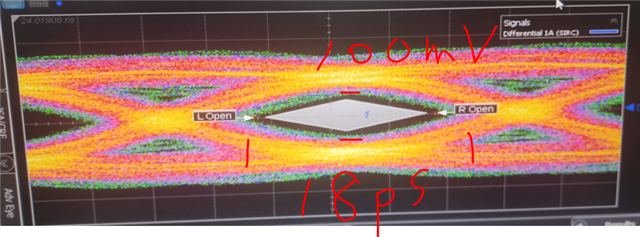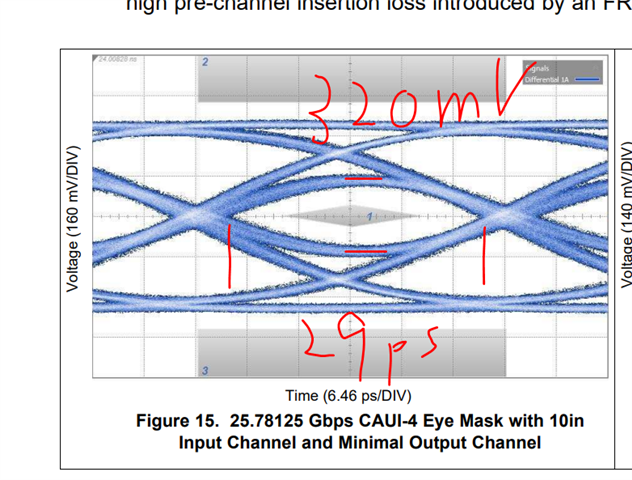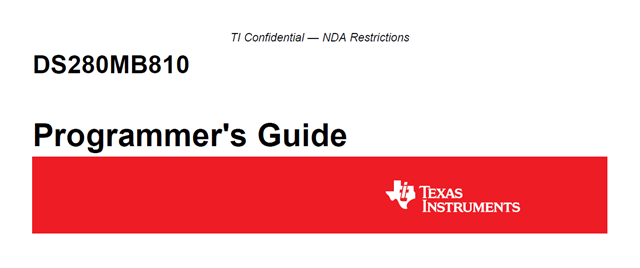Other Parts Discussed in Thread: DS280DF810
Hi TI expert,
Please help to solve my customer question for DS280MB810 application.
I listed all questions in below file. Thanks a lot.
This thread has been locked.
If you have a related question, please click the "Ask a related question" button in the top right corner. The newly created question will be automatically linked to this question.
Hi TI expert,
Please help to solve my customer question for DS280MB810 application.
I listed all questions in below file. Thanks a lot.
Hi Jin,
Can you share a block diagram showing how the DS280MB810 is used in this application? Does it handle both system ingress and egress traffic?
1) Please read the descriptions for each of these sections. These are guidelines that can be used as a starting point for your system configuration, but you may need to tune the device. Based on your description, I don't think you need the "backplane reach extension" configuration. If the DS280MB810 handles both ingress and egress traffic, then you may need the Front-Port Ingress/Egress configurations.
2) Yes, it is possible to consolidate the 3 register writes into a single register write. However, please note that the purpose of the 3 register writes is to only affect certain bits of the register using a read-modify-write procedure. Most writes in this programming guide have a write mask. This write mask indicates which bits will be impacted by a write. It is important to pay attention to this in order to avoid erroneous register writes.
For more details on read-modify-write (rmw) procedure, please see the excerpt below from our 10G retimer programming guide.

3) Can you provide more details about what is not clear? You will just need to adjust the I2C device address accordingly to select the correct device when configuring your two DS280MB810s.
4) Thanks for pointing this out. This is a typo, 0xF1 should read back 0x42.
Thanks,
Drew
Hi Drew,
Thanks for your quickly response.
The customer solved their concern.
There is another technical question for this device.
May I know DS280MB810 can support 25.78125Gbps for better eye waveform?
The following is the test result. The trace distance is 13inch and PCB material DS-7409DQN.
The eye mask are 100mV and 18ps.

The following is our EVM test result. The trace distance is 10in and PCB material FR-4.
The eye mask is 320mV and 29ps

May I know how to improve the eye mask on my customer's setting? or this is our device limitation?
Another question, if this is the limitation for DS2280MB810. Do we have the another p2p device that have higher performance for eye mask at 25Gbps?
Hi Jin,
A couple questions:
If the DS280MB810 cannot meet the customer's needs, DS280DF810 is effectively p2p. However, please note that DS280DF810 requires a 25 MHz reference clock.
Thanks,
Drew
Hi Drew,
Thanks for your quickly feedback.
Yes, my customer based on the DS280MB810 tuning guide (SNLU199) to fine tune the EQ and DC gain.

When they used 10Gbps VCO that eye mask pretty good, but after they choose 25Gbps VCO that even they fine tune the EQ and DC gain both can't enhance the eye mask.
Could you share some experience for enhance the eye mask?
May I know what's your meaning for DS280MB810 requires a 25 MHz reference clock?
I checked the latest roadmap for re-driver MUX. DS560MB810 is p2p with DS280MB810?
Hi Jin,
If the customer has already fine tuned EQ, DC gain, and EQ bandwidth, then I would recommend that they try tuning the TX pre/post cursor setting of the signal being sent to the DS280MB810 if possible. Adding some pre and post cursor emphasis can have a big impact, especially at 25Gbps.
May I know what's your meaning for DS280MB810 requires a 25 MHz reference clock?
Please note that this is for a similar device, the DS280DF810. This is a retimer that could be used if the DS280MB810 is not adequate in the customer's system.
Also, there is currently no plan to release DS560MB810.
Thanks,
Drew
Drew,
Please help to answer the following questions.
1. When DS280MB810 is used as MUX, does it still have the re-driver function?
2. DS280MB810 can compensate for loss, but is there a solution to the reflection caused by discontinuous via/conn impedance?
3. If the customer change solution from DS280MB810 to DS280DF810, does it can support 10G KR or not?
Hi Jin,
1) Yes, the DS280MB810 still applies CTLE while used as a MUX.
2) No, the DS280MB810 is a linear redriver. It will pass whatever signal it receives.
3) DS280DF810 does not support link training, which is one aspect of the 10G-KR protocol. DS280DF810 could support 10G-KR signaling if link training is disabled. Can you share a block diagram? 10G-KR is not used on front port applications, so I'd like to better understand how it fits into their system.
Thanks,
Drew